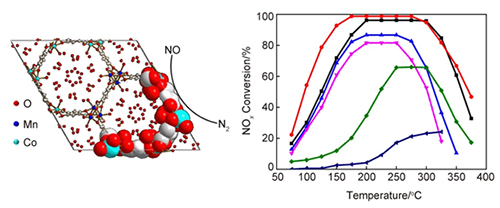| [1] Qu, Y.; An, J. L.; He, Y. J.; Zheng, J. J. Environ. Sci. 2016, 44, 13.
[2] Saikawa, E.; Kim, H.; Zhong, M.; Avramov, A.; Zhao, Y.; Janssens-Maenhout, G.; Kurokawa, J.; Klimont, Z.; Wagner, F.; Naik, V.; Horowitz, L. W.; Zhang, Q. Atmos. Chem. Phys. 2017, 17, 6393.
[3] Hamada, H.; Hanedab, M. Appl. Catal. A 2012, 421, 1.
[4] Skalska, K.; Miller, J. S.; Ledakowicz, S. Sci. Total Environ. 2010, 408, 3976.
[5] Liu, T. K.; Qian, J. N.; Yao, Y. Y.; Shi, Z. F.; Han, L. Y.; Liang, C. Y.; Li, B.; Dong, L. H.; Fan, M. G.; Zhang, L. L. J. Mol. Catal. A:Chem. 2017, 430, 43.
[6] Li, S. S; Wang, F. Z. R.; Liu, Y. M.; Cao, Y. Chin. J. Chem. 2017, 35, 591.
[7] Shin, H. U.; Lolla, D.; Nikolov, Z.; Chase, G. G. J. Ind. Eng. Chem. 2016, 33, 91.
[8] Liu, J.; Li, X. Y.; Zhao, Q. D.; Ke, J.; Xiao, H. N.; Lv, X. J.; Liu, S. M.; Tadéc, M.; Wang, S. B. Appl. Catal. B 2017, 200, 297.
[9] Lee, Y. R.; Kim, J.; Ahn, W. S. Korean J. Chem. Eng. 2013, 30, 1667.
[10] Wang, J. H.; Zhao, H. W.; Haller, G.; Li, Y. D. Appl. Catal. B 2017, 202, 346.
[11] Cai, S. X.; Liu, J.; Zha, K. W.; Li, H. R.; Shi, L. Y.; Zhang, D. S. Nanoscale 2017, 9, 5648.
[12] Shi, Y.; Tang, X. L.; Yi, H. L.; Gao, F. Y.; Zhao, S. Z.; Wang, J. G.; Yang, K.; Zhang, R. C. Ind. Eng. Chem. Res. 2019, 58, 3606.
[13] Shen, Q.; Zhang, L. Y.; Sun, N. N.; Wang, H.; Zhong, L. S.; He, C.; Wei, W.; Sun, Y. H. Chem. Eng. J. 2017, 322, 46.
[14] Cheng, X. X.; Bi, X. T. Particuology 2014, 16, 1.
[15] Dai, X. X.; Jiang, W. Y.; Wang, W. L.; Weng, X, L.; Shang, Y.; Xue, Y. H.; Wu, Z. B. Chin. J. Catal. 2018, 39, 728.
[16] Zhang, L.; Shi L. Y.; Huang L.; Zhang, J. P.; Gao, R. H.; Zhang, D. S. ACS Catal. 2014, 4, 1753.
[17] Liu, Z. Z.; Shi, Y.; Li, C. Y.; Zhao, Q. D.; Li, X. Y. Acta Phys.-Chim. Sin. 2015, 31, 9. (刘震震, 石勇, 李春艳, 肇启东, 李新勇, 物理化学学报, 2015, 31, 9.)
[18] Huang, G.; Chen, Y. Z.; Jiang, H. L. Acta Chim. Sinica 2016, 74, 113. (黄刚, 陈玉贞, 江海龙, 化学学报, 2016, 74, 113.)
[19] Xiao, J. D.; Jiang, H. L. Acc. Chem. Res. 2019, 52, 356.
[20] Jiao, L.; Wang, Y.; Jiang, H. L.; Xu, Q. Adv. Mater. 2018, 30, 1703663.
[21] Adhikari, A. K.; Lin, K. S. Chem. Eng. J. 2016, 284, 1348.
[22] Yan, L. T.; Dai, P. C.; Wang, Y.; Gu, X.; Li, L. J.; Cao, L.; Zhao, X. B. ACS Appl. Mater. Interfaces 2017, 9, 11642.
[23] Sun, D. R.; Ye, L.; Sun, F. X.; García, H.; Li, Z. H. Inorg. Chem. 2017, 56, 5203.
[24] Pliekhov, O.; Pliekhova, O.; Lavrencic štangar, U.; Logar, N. Z. Catal. Commun. 2018, 110, 88.
[25] Jiang, H. X.; Niu, Y.; Wang, Q. Y.; Chen, Y. F.; Zhang, M. H. Catal. Commun. 2018, 113, 46.
[26] Chen, S.; Xue, M.; Li, Y. Q.; Pan, Y.; Zhu, L. K.; Qiu, S. L. J. Mater. Chem. 2015, 3, 20145.
[27] Liu, T. K.; Yao, Y. Y.; Wei, L. Q.; Shi, Z. F.; Han, L. Y.; Yuan, H. X.; Li, B.; Dong, L. H.; Wang, F.; Sun, C. Z. J. Phys. Chem. C 2017, 121, 12757.
[28] Kim, S. H.; Lee, Y. J.; Kim, D. H.; Lee, Y. J. ACS Appl. Mater. Interfaces 2018, 10, 660.
[29] Nguyen, H. T. T.; Doan, D. N. A.; Truong, T. J. Mol. Catal. A:Chem. 2017, 426, 141.
[30] Liu, K. J.; Yu, Q. B.; Liu, J. L.; Wang, K.; Han, Z. C.; Xuan, Y. N.; Qin, Q. New J. Chem. 2017, 41, 13993.
[31] Hu, H.; Cai, S. X.; Li, H. R.; Huang, L.; Shi, L. Y.; Zhang, D. S. ACS Catal. 2015, 5, 6069.
[32] Qin, Y. L.; Huang, L.; Zheng, J. X.; Ren, Q. Inorg. Chem. Commun. 2016, 72, 78.
[33] Gao, F. Y.; Tang, X. L.; Yi, H. H.; Li, J. Y.; Zhao, S. Z.; Wang, J. G.; Chu, C.; Li, C. L. Chem. Eng. J. 2017, 317, 20.
[34] Dietzel, P. D. C.; Morita, Y.; Blom, R.; Fjellvag, H. Angew. Chem. Int. Ed. 2005, 44, 6354.
[35] Yan, L. T.; Cao, L.; Dai, P. C.; Gu, X.; Liu, D. D.; Li, L. J.; Wang, Y.; Zhao, X. B. Adv. Funct. Mater. 2017, 27, 1703455.
[36] Jiang, H. X.; Wang, Q. Y.; Wang, H. Q.; Chen, Y. F.; Zhang, M. H. ACS Appl. Mater. Interfaces 2016, 8, 26817. |
